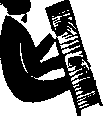Teach Yourself Jazz - online guidebook
For the beginning player, with sheet music samples
| Share page | Visit Us On FB |
|
CHAPTER TEN
JAZZ PIANO
FROM RAGTIME AND BOOGIE TO THE MODERNS
The piano was a latecomer to jazz. The rhythmic harmonic background of the pioneer jazz bands was furnished by guitar or banjo. But the piano (traditionally a front-parlour symbol of wealth and substance) became part of the fittings of the luxurious houses of pleasure in Storeyville. Once the piano was installed in these houses, then it became the custom to hire a 'Professor' who would sit at the piano and entertain the guests. If he had the technique and personality of a 'Jelly Roll' Morton, he could easily do this on his own without the aid of a band. For this is the great advantage of the piano—it is complete in itself. The left hand supplies the harmony and rhythm, the right hand supplies the melody line.
Little wonder, then, that jazz piano became enormously popular, and that there is a large and devoted following for pianists of the calibre of Fats Waller, Earl Hines, George Shearing and Oscar Peterson.
Purists will tell you that 'piano jazz' is really a contradiction in terms. "You cannot play jazz music
66
 |
||